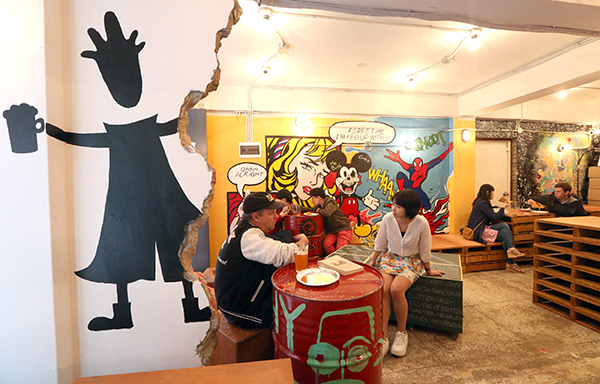Alley culture must be preserved, too

The once ordinary road has been changing in the last two to three years. Microbreweries, small diners and boutique stores have all opened there, offering things to see, eat and enjoy. The street is filled with young Koreans on Friday nights and weekends. But the unique neighborhood faces an uncertain future. A franchise coffee shop has opened at the entry to the road. While some might find it trivial, the lessons of the past suggest that the fate of the street is bleak.
Before Gyeongridan Road became popular, there were other streets beloved by the people of Seoul. Garosu-gil, Samcheong-dong, Itaewon, Hongdae and Sangsu-dong emerged as trendy spots in a similar pattern.
Young artists opened their studios, followed by unique cafes and restaurants. People seeking artistic charm gathered. Old laundry shops and photo studios added nostalgia. There were narrow two-lane alleys where visitors could walk around and enjoy the street’s environment.
But when a street becomes popular and pedestrian traffic increases, franchise coffee shops open, followed by brand-name shops for shoppers looking for cosmetics, apparel and accessories. Garosu-gil is full of large flagship stores of foreign brands, including Zara and H&M. A fashion designer who set up a studio in Garosu-gil is looking for a new site after the landlord sold the building to a corporate investor. She said, “I have to find a neighborhood that’s not going to become hot soon in order to keep the rent low and stay in one place for a long time.” Samcheong-dong and Hongdae are not much different.
It is not just about the mom-and-pop businesses. As the small shops disappear, the color and culture of the streets go extinct as well. The not-yet-famous designers, chefs and patissiers were not just in the business to make money, but also produced trends to create a new culture. Will the streets be as charming after they are gone?
In 2012, New York City designated a special enhanced commercial district for neighborhood retail streets on the Upper West Side. In order to provide diverse and traditional retail experiences, each store’s width should not exceed 12 meters (40 feet), and there must be at least two stores in a 15-meter-wide lot. It was a clever plan to save the small shops and unique streets.
The streets may remain intact, but culture can disappear in the blink of an eye. Spaces that took a long time to mature could go stale easily. Why can’t we have a laid-back commercial zone where we can relax and take a break from Myeongdong or Gangnam? Cultural preservation applies to streets and alleys as well.
JoongAng Ilbo, March 6, Page 30
*The author is a staff writer for the JoongAng Sunday.
By LEE DO-EUN
서울에서 요즘 가장 뜬다는 곳은 경리단길이다. 지하철 6호선 녹사평역에서 하얏트서울 호텔에 이르는 950m의 2차선 오르막길. 행정구역상 명칭은 이태원2동 회나무길이지만 부근에 육군중앙경리단이 있어 그리 불리게 됐다. 평범했던 이 골목길이 2~3년 새 조금씩 달라져 왔다. 개인이 운영하는 수제 맥줏집, 초소형 식당, 빈티지 그릇 가게 등이 문을 열면서 '볼거리, 먹거리, 재미거리 많은 곳'이 됐다. 이제는 금요일 저녁이나 주말이면 2030들의 약속 장소로 거리에 활기가 넘친다. 하지만 최근 빨간 불이 켜졌다. 길 초입에 프랜차이즈 커피숍이 들어 왔다. 이 정도가 무슨 대단한 일일까 싶지망 그간의 '학습 효과'로 보자면 비관적일 수밖에 없다. 경리단길이 인기를 끌기 전 서울엔 도시인의 아지트로 사랑 받던 골목들이 있었다. 가로수길, 삼청동, 이태원, 홍대 앞, 상수동이다. 생겨 난 패턴도 비슷하다. 젊은 예술가들의 작업실이 들어서면서 주변에 이색적인 카페와 식당이 문을 열었고, 감각적인 공간들을 찾아 사람들이 모여들었다. 오래 된 세탁소나 사진관조차 허투루 보이지 않는 곳이 그런 길이 됐다. 게다가 2차선의 좁은 도로라 걸어다니며 '골목 컨텐트' 그 자체를 즐길 수 있다는 매력도 뜨는 골목들의 공통점이었다. 문제는 그 다음이었다. 유동인구가 늘자 프랜차이즈 형태의 커피숍을 시작으로, 화장품·의류·액세서리 등 쇼핑족을 위한 브랜드 매장이 들어섰다. 가로수길의 경우, 자라·H&M 같은 글로벌 의류 매장은 물론 해외 브랜드들의 대형 플래그십스토어로 이미 가득 차 있다. 가로수길에 작업실을 둔 한 패션 디자이너는 세 든 건물이 기업에 팔리면서 요즘 새로운 둥지를 찾고 있다. 그러면서 하는 말이 "금세 뜨지 않을 동네를 찾아야 월세 오르지 않고 오래 버틸 수 있다"고 했다. 삼청동도 홍대 앞도 이와 별반 상황이 다르지 않을 터다. 또다시 골목 상권 문제를 운운하자는 게 아니다. 다만 작은 가게들이 사라지면서 길만의 색깔과 문화가 사라지는 현상이 안타깝다. 무명의 디자이너와 셰프와 파티시에들-. 돈 벌자고 가게를 차렸지만 새로운 문화를 퍼뜨리는 '트렌드 생산자'가 돼 줬기에 지금의 길이 생겼다. 그들이 사라진 뒤에도 골목의 재미가 그대로일 수 있을까. 뉴욕시는 2012년 '어퍼웨스트사이드(UWS) 지역 소매점 거리를 위한 특별 상업 지구' 계획을 추진했다. 예술가들이 몰려 있던 소호 지역이 지나치게 사업화 되자 한 가게의 최대 폭은 12m를 넘어선 안 되고 15m의 폭 안에는 적어도 2개의 가게가 들어서야 한다는 정책을 내놨다. 작은 가게를, 아니 골목을 살리려는 묘안이었다. 길은 그대로일지라도 문화는 순식간에 사라진다. 오랜 시간 숙성시킨 공간들 역시 쉽게 변질된다. 명동이나 강남역과 다른, 안식과 휴식이 함께 하는 상권이 존재할 수 없는 걸까. 문화 보존, 골목에도 필요하다.










with the Korea JoongAng Daily
To write comments, please log in to one of the accounts.
Standards Board Policy (0/250자)